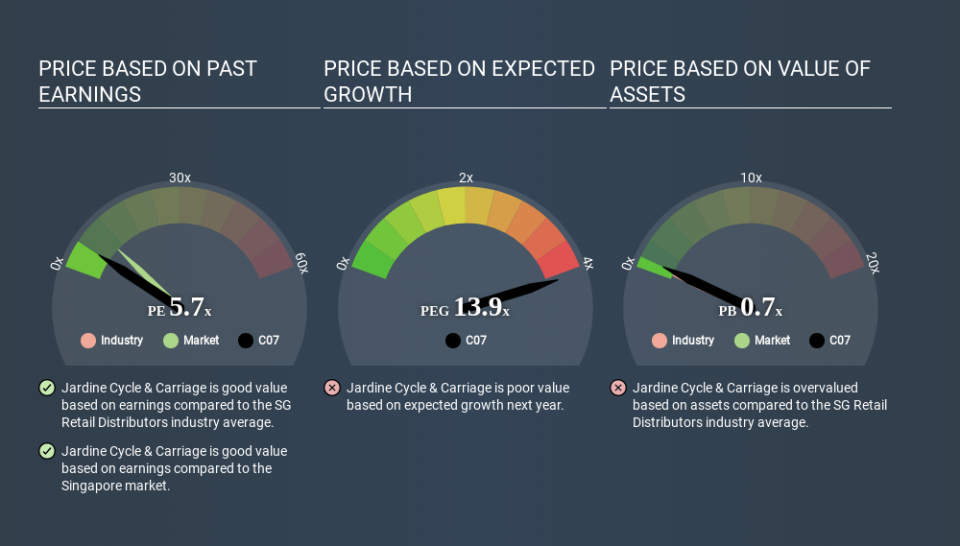How Does Jardine Cycle & Carriage's (SGX:C07) P/E Compare To Its Industry, After The Share Price Drop?

Unfortunately for some shareholders, the Jardine Cycle & Carriage (SGX:C07) share price has dived 31% in the last thirty days. That drop has capped off a tough year for shareholders, with the share price down 47% in that time.
Assuming nothing else has changed, a lower share price makes a stock more attractive to potential buyers. While the market sentiment towards a stock is very changeable, in the long run, the share price will tend to move in the same direction as earnings per share. The implication here is that long term investors have an opportunity when expectations of a company are too low. Perhaps the simplest way to get a read on investors' expectations of a business is to look at its Price to Earnings Ratio (PE Ratio). A high P/E implies that investors have high expectations of what a company can achieve compared to a company with a low P/E ratio.
See our latest analysis for Jardine Cycle & Carriage
Does Jardine Cycle & Carriage Have A Relatively High Or Low P/E For Its Industry?
Jardine Cycle & Carriage has a P/E ratio of 5.73. As you can see below Jardine Cycle & Carriage has a P/E ratio that is fairly close for the average for the retail distributors industry, which is 6.1.
That indicates that the market expects Jardine Cycle & Carriage will perform roughly in line with other companies in its industry. The company could surprise by performing better than average, in the future. I would further inform my view by checking insider buying and selling., among other things.
How Growth Rates Impact P/E Ratios
Earnings growth rates have a big influence on P/E ratios. When earnings grow, the 'E' increases, over time. Therefore, even if you pay a high multiple of earnings now, that multiple will become lower in the future. And as that P/E ratio drops, the company will look cheap, unless its share price increases.
In the last year, Jardine Cycle & Carriage grew EPS like Taylor Swift grew her fan base back in 2010; the 110% gain was both fast and well deserved. Having said that, the average EPS growth over the last three years wasn't so good, coming in at 7.9%.
Remember: P/E Ratios Don't Consider The Balance Sheet
Don't forget that the P/E ratio considers market capitalization. So it won't reflect the advantage of cash, or disadvantage of debt. In theory, a company can lower its future P/E ratio by using cash or debt to invest in growth.
Such spending might be good or bad, overall, but the key point here is that you need to look at debt to understand the P/E ratio in context.
Is Debt Impacting Jardine Cycle & Carriage's P/E?
Jardine Cycle & Carriage has net debt worth a very significant 123% of its market capitalization. This level of debt justifies a relatively low P/E, so remain cognizant of the debt, if you're comparing it to other stocks.
The Verdict On Jardine Cycle & Carriage's P/E Ratio
Jardine Cycle & Carriage trades on a P/E ratio of 5.7, which is below the SG market average of 10.2. The company may have significant debt, but EPS growth was good last year. If the company can continue to grow earnings, then the current P/E may be unjustifiably low. What can be absolutely certain is that the market has become more pessimistic about Jardine Cycle & Carriage over the last month, with the P/E ratio falling from 8.3 back then to 5.7 today. For those who prefer invest in growth, this stock apparently offers limited promise, but the deep value investors may find the pessimism around this stock enticing.
Investors should be looking to buy stocks that the market is wrong about. If it is underestimating a company, investors can make money by buying and holding the shares until the market corrects itself. So this free visual report on analyst forecasts could hold the key to an excellent investment decision.
Of course, you might find a fantastic investment by looking at a few good candidates. So take a peek at this free list of companies with modest (or no) debt, trading on a P/E below 20.
If you spot an error that warrants correction, please contact the editor at editorial-team@simplywallst.com. This article by Simply Wall St is general in nature. It does not constitute a recommendation to buy or sell any stock, and does not take account of your objectives, or your financial situation. Simply Wall St has no position in the stocks mentioned.
We aim to bring you long-term focused research analysis driven by fundamental data. Note that our analysis may not factor in the latest price-sensitive company announcements or qualitative material. Thank you for reading.


